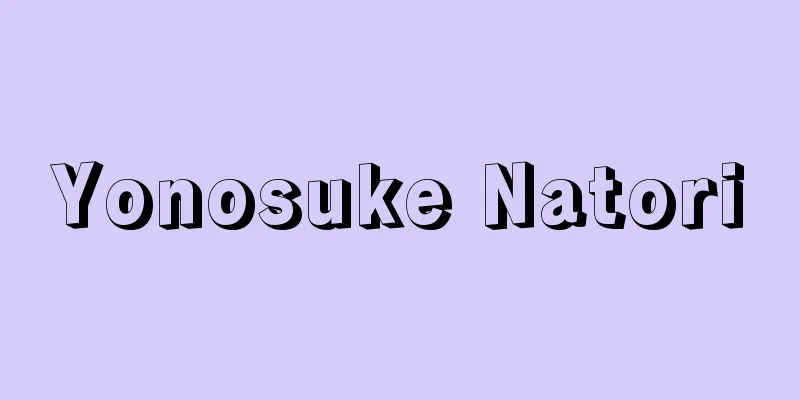Yonosuke Natori

|
Photographer and photo editor. Born in Takanawa, Tokyo. In the 1930s, he introduced and practiced the methodology of reportage photography from Germany to Japan, and was involved in the production of numerous graphic magazines and photo publications from before World War II, through the war, and into the 1950s after the war. In 1928 (Showa 3), after graduating from Keio Gijuku Junior High School, he moved to Germany with his mother. He studied commercial art at the School of Arts and Crafts in Munich, and in 1930 he began working as a textile designer at a woolen mill there. That same year, he married craft designer Erna Mecklenburg, and they remained partners in work until World War II. In 1931, he acquired a new model of compact camera, a Leica, and was taught the basics of photography by an acquaintance. That same year, he took photos taken by his wife Erna of the ruins of the fire at the Munich City Museum to a local newspaper, and they were published. He then began working as a photojournalist, becoming a contract photographer for the major German newspaper and magazine publisher Ulstein, and in 1957 he returned to Japan temporarily as a correspondent for the company. He covered Japanese culture, lifestyle, nature, and more, taking 7,000 photos in three months. The results of his coverage were distributed to newspapers and magazines around the world in the form of photo series with titles such as "Japanese Inns," "Japanese Family Life," "Kimono and Hair," and "Tokyo Streets." In 1933, he covered the Manchurian Incident, but after the ceasefire, Hitler's government imposed restrictions on foreigners' employment in Germany, so instead of returning to Germany he moved his base of operations to Japan. That same year, aiming to put into practice the new concept of "photojournalism," he founded Nippon Koubou (First Studio) with photographer Kimura Ihei, planner Okada Sozo (1903-83), photography critic Ina Nobuo, and graphic designer Hara Hiromu. The following year, with the help of graphic designer Yamana Ayao (1897-1980) and others, he founded Nippon Koubou (Second Studio), which launched the graphic magazine NIPPON, which promoted Japanese culture overseas. Through editing the magazine, Natori pursued ways to use photography functionally as a symbol for visual communication. With a staff of photographers Domon Ken and Fujimoto Shihachi (1911-2006), and designer Kamekura Yusaku, he created a magazine with a sophisticated style that stood out for its time. In 1937, he traveled to America for reporting, and his photographs of the New England region were published in Life magazine. The following year, during the Second Sino-Japanese War, he was involved in the launch of the foreign propaganda graphic magazines SHANGHAI and CANTON in Shanghai, and after reorganizing Nippon Kobo into International Press Crafts (1939), he was mainly involved in military propaganda and publishing activities in mainland China until the end of World War II. After Japan lost the war, he edited Weekly Sun-News (1947-49), which aimed to be a Japanese version of Life, and Iwanami Photo Library (1950-58), a publication that used a photo-centered layout to illustrate a single theme in each issue. In 1956 (Showa 31), he photographed the Maijishan Grottoes, a Buddhist site in China located southeast of Tianshui County, Gansu Province. From 1959, he traveled to Europe four times, photographing Romanesque sculptures and patterns. [Kinichi Ohirakata] "Mugizumiyama Grottoes" (1957, Iwanami Shoten) ▽ "Romanesque: The Origin of Western Beauty" (1962, Keiyusha) ▽ "Human-Animal Patterns - Romanesque Art and Its Surroundings" (1963, Keiyusha) ▽ "America 1937 - Natori Yonosuke Photograph Collection" (1992, Kodansha) ▽ "How to Read Photographs" (Iwanami Shinsho) ▽ "Grosses Japan (1937, Karl Specht, Berlin)" ▽ "Natori Yonosuke's Era" by Nakanishi Akio (1981, Asahi Shimbun) ▽ "The Selfish Natori Yonosuke" by Mikami Masahiko (1988, Chikuma Shobo) ▽ "The Youth of Photojournalism - Natori Yonosuke and His Friends" by Ishikawa Yasumasa (1991, Kodansha) ▽ "Japanese Photographers 18 "Natori Yonosuke" (1998, Iwanami Shoten)" ▽ "The Work of Natori Yonosuke = Great Japan" (Catalogue, 1978, Seibu Museum of Art) [References] | | | | | |Source: Shogakukan Encyclopedia Nipponica About Encyclopedia Nipponica Information | Legend |
|
写真家・写真編集者。東京・高輪(たかなわ)生まれ。1930年代にルポルタージュ・フォト(報道写真)の方法論をドイツから日本へ移入・実践し、第二次世界大戦前から戦中、戦後の1950年代までにかけて数々のグラフ雑誌や写真出版物の制作にたずさわった。1928年(昭和3)、慶応義塾普通部を卒業後母とともにドイツへ渡る。ミュンヘンの美術工芸学校で商業美術を学び、30年同地の毛織物工場でテキスタイル・デザインの仕事につく。同年、工芸デザイナーのエルナ・メクレンブルクと結婚、以後第二次世界大戦中まで、仕事上でもパートナーとして行動をともにする。31年小型カメラの新機種ライカを入手、知人より写真の手ほどきを受ける。同年、妻エルナが撮影したミュンヘン市立博物館の火事場跡の写真を地元新聞に持ち込み、掲載される。以後、フォトジャーナリスト活動を始め、ドイツの大手新聞・雑誌出版社ウルシュタイン社の契約写真家となり、32年同社特派員として日本へ一時帰国。日本の文化、生活様式、自然などを取材し、3か月で7000枚の写真を撮影。それらの取材成果は「日本の宿屋」「日本の家庭生活」「着物と髪」「東京の街頭」というタイトルの組写真の形で各国の新聞・雑誌に配信された。 1933年満州事変を従軍取材、停戦後、ヒトラー政権のドイツ国内外国人就労規制が打ち出されたため、ドイツへ戻らず日本に活動の本拠を移す。同年、「報道写真」という新しい理念の実践を目ざし、写真家の木村伊兵衛、プランナーの岡田桑三(そうぞう)(1903―83)、写真評論家の伊奈信男、グラフィック・デザイナーの原弘(ひろむ)と日本工房(第一次)を設立。翌年、新たにグラフィック・デザイナー山名文夫(あやお)(1897―1980)らの協力を得て第二次日本工房を創設、海外向け日本文化宣伝グラフ誌『NIPPON』を創刊。同誌の編集を通じ名取は、写真を視覚伝達のための記号として機能的に使いこなす方法を追求。写真担当土門拳、藤本四八(しはち)(1911―2006)、デザイン担当亀倉雄策らのスタッフを得て、当時にあっては群を抜く洗練されたスタイルの誌面作りを展開した。1937年アメリカを取材旅行、ニュー・イングランド地方を撮影した写真が『ライフ』誌に掲載される。翌年、日中戦争下の上海(シャンハイ)で対外宣伝グラフ誌『SHANGHAI』『CANTON』の創刊にたずさわり、さらに日本工房を国際報道工芸に改組(1939)して以降、第二次世界大戦終結までおもに中国大陸で軍関係の宣伝や出版活動に従事した。 敗戦後、日本版『ライフ』を目ざした『週刊サンニュース』の編集(1947~49)や、写真を中心とするレイアウトで1冊ごとに一つのテーマを図解していくスタイルの出版物『岩波写真文庫』の編集(1950~58)を手がける。56年(昭和31)には中国の仏教遺跡・甘粛(かんしゅく/カンスー)省天水県南東の麦積山石窟(ばくせきざんせっくつ)を撮影。59年からは4回にわたり渡欧し、ロマネスク美術の彫刻や文様を撮った。 [大日方欣一] 『『麦積山石窟』(1957・岩波書店)』▽『『ロマネスク 西洋美の始源』(1962・慶友社)』▽『『人間動物文様――ロマネスク美術とその周辺』(1963・慶友社)』▽『『アメリカ1937――名取洋之助写真集』(1992・講談社)』▽『『写真の読みかた』(岩波新書)』▽『Grosses Japan (1937, Karl Specht, Berlin)』▽『中西昭雄著『名取洋之助の時代』(1981・朝日新聞社)』▽『三神真彦著『わがままいっぱい名取洋之助』(1988・筑摩書房)』▽『石川保昌著『報道写真の青春時代――名取洋之助と仲間たち』(1991・講談社)』▽『『日本の写真家18 名取洋之助』(1998・岩波書店)』▽『「名取洋之助の仕事=大日本」(カタログ。1978・西武美術館)』 [参照項目] | | | | | |出典 小学館 日本大百科全書(ニッポニカ)日本大百科全書(ニッポニカ)について 情報 | 凡例 |
Recommend
beret
〘Noun〙 (béret, berret)⸨Belle Vere⸩ A round, flat, ...
Brain death - Noushi
Brain death is a state in which all brain functio...
Naganuma [town] - Naganuma
A town in Yubari County, Hokkaido. The eastern par...
Wea Aemilia - Wea Aemilia
… The region is made up of the Emilia and Romagna...
Hypothesis Experiment Lesson - Hypothesis Experiment Lesson
A class organized around a series of steps: predic...
Gebrauchspoesie
...The contribution of Expressionist poets in thi...
"Kanmon Gyoki" - Kanmon Gyoki
…The entire 44 volumes of the original handwritte...
Coțofeneşti-Prahova (English spelling)
...The curved patterns on painted pottery from th...
Social Welfare Council
A private organization organized to promote socia...
dzong
…They practice Hinduism or Buddhism and make up a...
Actour - Actour
… [Around the word "actor"] The concept...
Painter Huang Wen - Painter Huang Wen
… In this way, foreign relations during the princ...
Kinsey, AC - Kinsey
… In this way, multifaceted medical and behaviora...
East [town] - Azuma
A former town in Inashiki County in southern Ibara...
Afterword to Honpukuji Temple
This is a record written by Myozei, the abbot of H...









